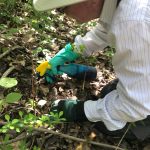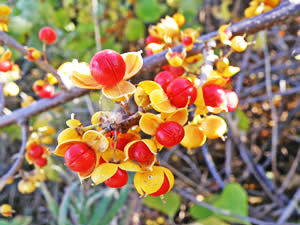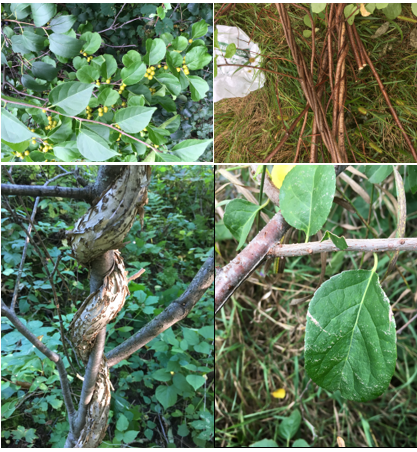Volunteer Work Days
 If you’d like to volunteer to help the County remove oriental bittersweet please email mjohnson@co.winona.mn.us for more information and to sign up! You can also visit our volunteer event page on Facebook.
If you’d like to volunteer to help the County remove oriental bittersweet please email mjohnson@co.winona.mn.us for more information and to sign up! You can also visit our volunteer event page on Facebook.
Upcoming Work Days (from 9AM-12PM each day)
- Wednesday, November 7th
- Friday, November 9th
- Saturday, November 10th
- Tuesday, November 13th
- Wednesday, November 14th
- Friday, November 16th
- Saturday, November 17th
Oriental Bittersweet Eradication Efforts
American Bittersweet is beloved for its bright red berries and it ability to be twisted into festive wreaths. Unfortunately its cousin, Oriental Bittersweet, although still beautiful as an autumnal wreath, is an aggressive invasive species is devastating hardwood forests.
 Winona County has the densest Oriental Bittersweet infestation in Minnesota. With the funds provided by a 2018 Minnesota Department of Agriculture (MDA) grant, collaboration between the MDA, the Department of Natural Resources (DNR), Soil and Water Conservation District (SWCD), U.S. Fish and Wildlife Service (USFWS), and the City of Winona, as well extensive community buy-in, Winona County has started to create a road map to recovery.
Winona County has the densest Oriental Bittersweet infestation in Minnesota. With the funds provided by a 2018 Minnesota Department of Agriculture (MDA) grant, collaboration between the MDA, the Department of Natural Resources (DNR), Soil and Water Conservation District (SWCD), U.S. Fish and Wildlife Service (USFWS), and the City of Winona, as well extensive community buy-in, Winona County has started to create a road map to recovery.
Our plan is to supply Winona County citizens with the resources and knowledge to combat Oriental Bittersweet on their own. We’ve met with over 25 landowners, held 3 outreach events with over 150 total attendees, and distributed more than 5 gallons of free, pre-mixed herbicide to affected property owners. In creating a community consensus and providing herbicide we are laying the groundwork for continued efforts after the grant period closes. And, although the focus has been working with private landowners, we’ve also done extensive eradication on county property at Stone Point and Farmers Park.
Our initial goal was to treat 60 acres of infested land, and we’ve already treated 75 acres, with a month still left in the grant period. We’ve also surveyed an additional 200 acres of land, all the while making maps of each work site to make future eradication efforts more directed and effective. Additionally, volunteers have put in more than 300 eradication hours, showing the time and dedication local residents have devoted to this problem.
These grant funds have been essential to getting our Oriental Bittersweet management program up-and-running, but this initial grant is only the start. We’ve discovered vines more than 45 years old on some heavily infested properties. By engaging community members, collaborating in management efforts with relevant governmental departments, and creating a detailed map of infestation levels, we hope to establish a foundation for continued removal efforts in the years to come.
Oriental Bittersweet Identification & Treatment Basics
Identification
- Yellow capsules covering red berries
- Capsules spread along the entire length of the vine
- Bark is very rough and often turns a whitish-tan color on larger vines
- Often runs along the ground for very long distances
Treatment
- Oriental Bittersweet cannot only be cut, it must be treated with a strong herbicide. If not treated, Oriental Bittersweet comes back more aggressive and becomes much more difficult to manage.
- When using herbicides, a person needs to wear gloves, eye protection, long pants and long sleeves. Wash your hands after handling the herbicide, especially before eating or drinking.
- How to Treat:
- Locate vine, following it to the source in the soil
- Cut once at ground level
- Cut again 4 to 5 feet about the ground
- Spray cut stump with a small amount of herbicide; just enough to cover the exposed, cut surface of the vine
- Pile cut vines for later removal
